
This is a guest post by Jory MacKay. MacKay is a productivity obsessed writer and editor of the RescueTime blog. He loves to use data and storytelling to help people take back control of their time.
A recent survey of 850+ knowledge workers from around the world found that 92% of people regularly work on evenings and weekends. That’s a terrifying statistic. And while it’s easy to lay the blame on ballooning priorities and overwhelmed teammates, those are only a small part of a bigger problem.
Poor time management strategies seem to be the underlying issue, and in this Process Street article, we will explain how you can remedy this.
Our days have become cluttered with busywork, non-stop communication, and unclear priorities. We rarely have more than half an hour to focus on any one task at a time and so we end up taking our most important work home with us to make progress.
But as study after study has shown, we need to be able to disconnect from the workday to stay happy, healthy, and productive.
So how can you help your team take back control of their time, make meaningful progress on important work, and still punch out at the end of the day? It comes down to a combination of using the right data and adopting effective time management strategies.
In this article, we will cover:
- Time management strategies and how to prioritize your time with Process Street
- Team time management: The perfect storm of busy work and bias that eats up your team’s time
- How to improve personal productivity and track where your time goes
- 5 time management techniques: Ways to give your team more time each day
Time management strategies: How to prioritize your time with Process Street
To kick-off this article I will introduce Process Street as your ultimate, free, time-management tool you can use to define an action plan for long-term efficient use of your time.
How can Process Street save you time?
Process Street is superpowered checklists. That is, you can document any business process, utilizing features such as dynamic due dates, stop tasks, conditional logic, and approvals to create dynamic checklist machines. By documenting internal processes, you and your team can work more productively and at maximum efficiency, saving time.
Once more, you can create checklists specifically designed to help you strategize your day/working week to get more done. For instance, check out Process Street’s Prioritization Matrix Checklist Template. You can use this checklist to create a 2×2 prioritization matrix to set your working priorities for tasks, projects, and solutions.
Click here to access our Prioritization Matrix Checklist Template!
For more information on how you can create and edit templates in Process Street, watch the below video: Basics of Creating and Editing Templates.
Team time management: What’s eating up your team’s time?
Team time management differs from personal time management. Team time management looks at work-done within a team. It focuses on organizational rhythm centering on groups of people working together as opposed to working as individuals.
Ask most people how long they work each day and they’ll most likely tell you somewhere between 8 and 10 hours. Yet, despite the 8-hour day being the norm for over a century, no one does 8 hours of work a day.
According to research, in an 8-hour workday, only 2 hours and 48 minutes is productive.
This isn’t to say that those other 5+ hours are completely wasted, but that we rarely use them as efficiently as we’d like to (or plan to).
So where does the time go?
There are two main culprits you need to understand: Busy work and cognitive biases.
How to improve personal productivity and track where your time goes
Personal productivity is a measure of balance and ease brought to your life by completing actions that move you closer to your goals.
Statistically speaking, it is unlikely that you obtain a 50% return on your time investment each workday. Where is your time going?
The easiest way to understand where your time goes each day is to break up your usual tasks and responsibilities into some basic categories:
- Core work: This is the task you were hired to do (software development for developers, writing for writers, designing for designers, etc…)
- Communication/collaboration: This includes emails, calls, and meetings.
- Everything else: Everything else you do to support your job such as admin work, organization, etc…
In an ideal world, you’d spend the majority of your day on core work. But let’s stick to reality for now.
In one study published in the Harvard Business Review, researchers found that in most companies, employees spend 80% of their day on communication, collaboration, and busywork. This leaves little time for critical work, meaning employees are pushed to complete this in their own time.
At best, you have 1/5th of your day to focus on core work. But even those hours aren’t free from distraction.
We’ve normalized (and even begun to celebrate) our busyness. It’s normal to spend all day bouncing between emails, calls, and meetings, all while trying to fit in meaningful work in 5-minute gaps.
Spending your work-days like this, we end up working longer hours, taking work home with us, and being susceptible to burnout.
As Brigid Schulte, author of Overwhelmed: Work, Love and Play When No One Has the Time, writes:
“Unlike a century ago, when Americans showed their status in leisure time, busyness has become the new badge of honor.”
Bias: Why your team’s productive hours are at risk
We all follow several cognitive biases. These are mental shortcuts our brains have developed over time, influencing our thinking. While some biases can be helpful, others eat away at our productive time. Below are a few of the worst offenders:
- The Planning Fallacy: We tend to be overconfident in what we can accomplish in a day even if we’ve done those tasks in the past. This means we overcommit and load our already full days with too much work than is humanly possible. The Planning Fallacy explains why you’re planning for 8 hours of solid, focused work, even though you’re likely to complete 50% of that planned work.
- Cognitive tunneling: Research has found that one of the most motivating things you can do is make meaningful progress on important work. Yet thanks to cognitive tunneling, when we become overwhelmed with busywork (as we saw) we end up focusing on the most immediate (and often low-value) tasks. This not only keeps us feeling like we need to catch up, but also kills our motivation.
- Context switching: Finally, with many competing tasks and obligations, it’s tempting to try and multitask. However, research has shown that even switching between two tasks – such as an open inbox and another project – can kill 20–80% of your productive time a day! As you try to make up for this lost time, you’re actively killing the productive time you have.
All this leads to a grim conclusion of over-working and stress.
5 time management strategies to free up your team’s schedule
Time management techniques organize and plan how time is divided between specific tasks.
It’s easy to see how the day can get away from you and your team. But it’s not all bad news.
With a few changes to how you approach the workday, you can help your team be more efficient with their time, avoid collaboration overload, and counter the natural biases that kill your productivity.
Help them understand where your team time goes
If you want to be more productive and efficient with your time, you track how you spend your time.
A time tracking tool like RescueTime gives you the data and insights you need to uncover the invisible distractions and habits that eat up your day.
(You can also run through these exercises using a more basic system: paper and pencil. Ask your team to take a week where they run a time audit and track what they’re working on in 5-10-minute blocks. After a week, you’ll have a good amount of data to work with.)
RescueTime works in the background of all your devices to automatically track how you spend your time. Once you start using it, you’ll quickly get a baseline of your productivity and see the tools and apps that are taking up your time.
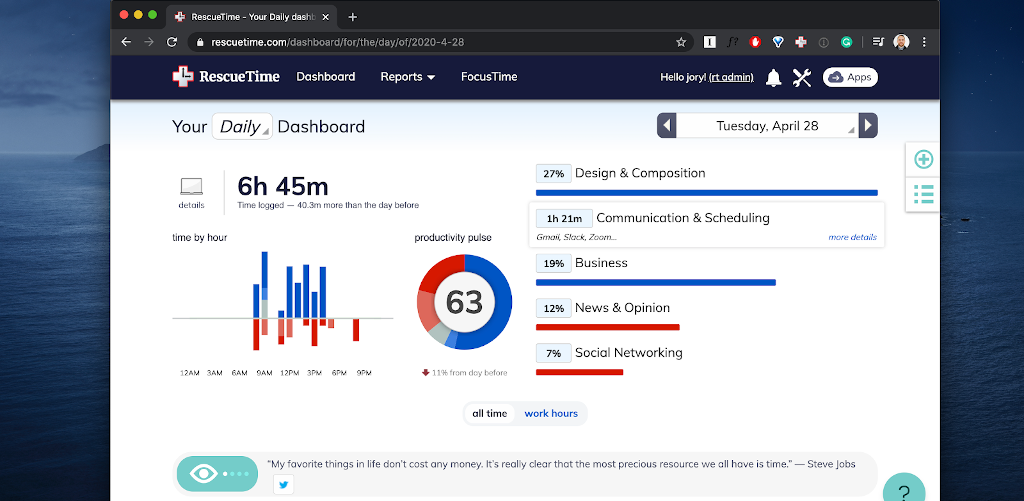
You can dig into individual categories of apps and sites, compare your productive vs distracted time, or look at larger trends in your workday.
Start by looking at your total distracting time report. This will show you the sites and apps that are pulling at your attention as well as how much time you spent on them today – considering a daily, weekly, monthly, or yearly time-scale.
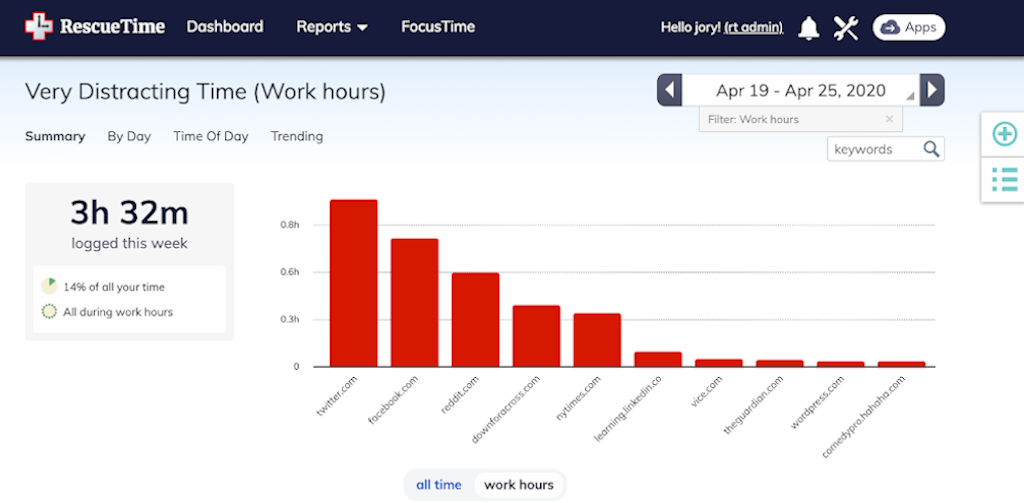
Next, check this report by the time of day. This will show you exactly when during the day you’re checking in on these distractions.
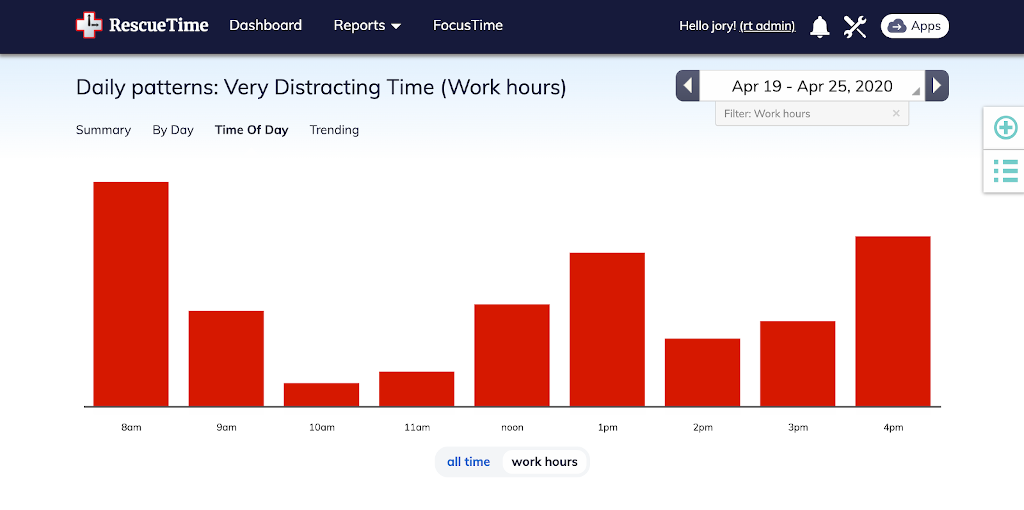
In my case, I have a bad tendency to start my day with distractions (*cough* Twitter *cough*) and then fall victim to it again during the afternoon slump.
You can do this same exercise with your productive time to see when you’re doing your best work. The data can sometimes be hard to see, but it’s the insight you need to start fixing your habits and fight against bias and busywork.
Create a daily schedule based on their personal productivity trends
The key to being more productive isn’t working more. It’s not even being more efficient with your time. To get the most out of your time, you need to work at the right time.
We all have times during the day when we’re more energized and focused (scientists call this our Circadian Rhythm). Research shows we’re more likely to get into a state of flow and be 500% more productive during these moments.
In other words, even if you only have 2-3 productive hours a day, if you plan them properly, you can get a full day’s worth of work out of them.
The same report we looked at above for distracting time can also be used to uncover your most productive hours. We like to call this your productivity cure. Below is what mine looks like:
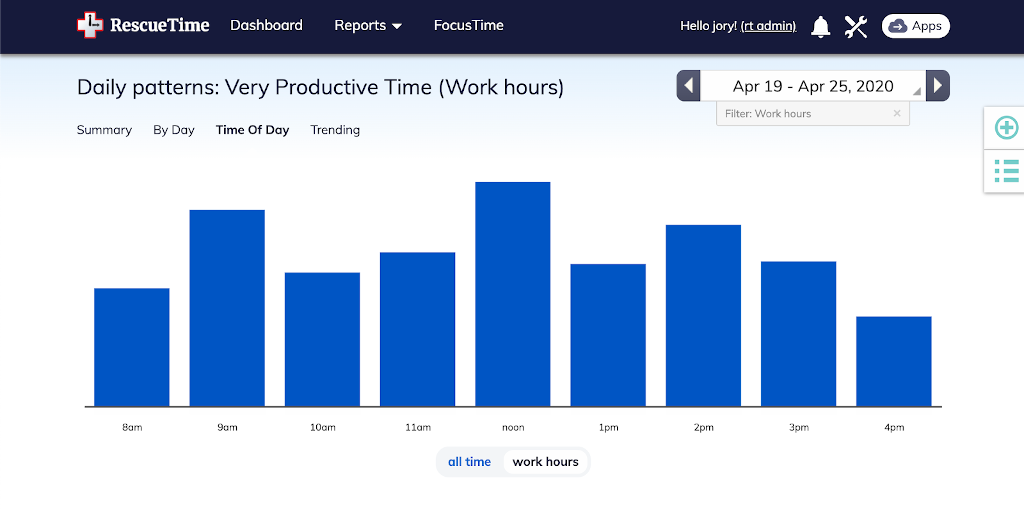
According to my data, my most productive times are at 9 am and noon. During these times, I should be minimizing distractions, scheduling head-down work, and turning off my email, chat, and phone.
However, your productivity cure doesn’t just help you find your peak hours. You can use this information to time-block your entire daily schedule. Time blocking is when you plan out each moment of your day in advance and dedicate specific time blocks to certain tasks.
Below is a small example:
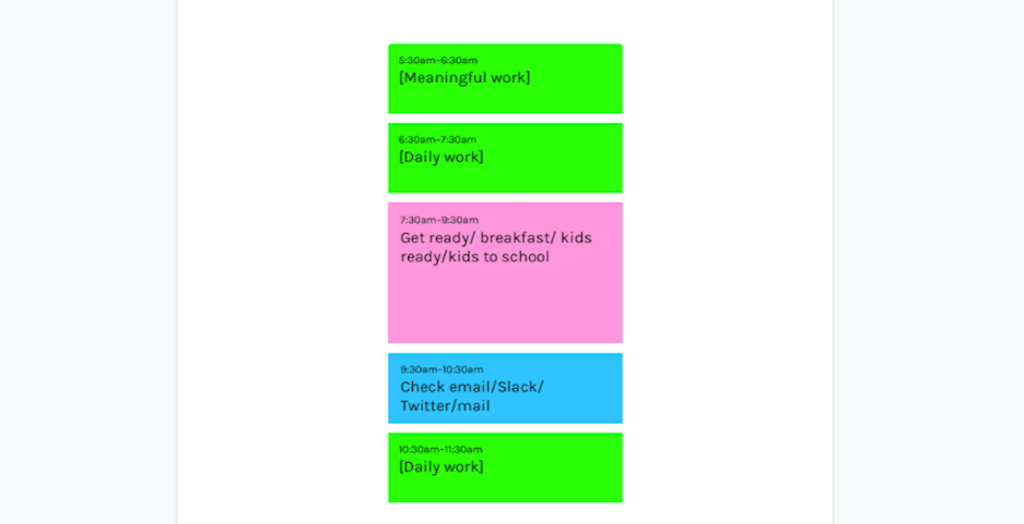
In a nutshell, you want to schedule:
- Focused work during your peak productive hours,
- Meetings, calls, and emails when your energy levels (and productivity) is naturally lower,
- Breaks when you’re most distracted and need to recharge.
This might sound like a lot of work, but the results can be massive. As Deep Work author Cal Newport writes:
“A 40-hour time-blocked work week, I estimate, produces the same amount of output as a 60+ hour work week pursued without structure.” – Cal Newport, Deep Work
Use bursts of communication throughout the day
The busywork that takes over people’s working day often comes in the form of chat apps like Slack or video calls on Zoom. With lots of ongoing communication, it can feel like you have little time for anything else.
When we analyzed data from more than 50,000 knowledge workers, we found that most people can’t go 6 minutes without checking their email or chat apps during the workday.
New research published by the Harvard Business School showed the most productive and creative teams communicate intermittently. As the study’s authors wrote:
“During a rapid-fire burst of communication, team members can get input necessary for their work and develop ideas. Conversely, during long periods of silence, everyone is presumably hard at work acting upon the ideas that were exchanged in the communication burst.” – Rob Cross, Reb Rebele, Adam Grant, Collaborative Overload
However, communicating in bursts only works if everyone on your team (yourself included) follows the rule. This means setting clear expectations around availability (which we’ll get into below) as well as leading by example.
In a recent survey on how people communicate, 61% of people said they regularly reply to work emails outside of work hours. The more you massage your team, the more they’ll feel compelled to check in, context switch, and kill their focus.
Batch meetings and other collaborative tasks
Emails, calls, and chats aren’t the only things that benefit from being done in bursts. Your team will also benefit from batching different types of tasks. Instead of peppering meetings and calls in between focused time, help your team protect their peak hours by batching meetings or even responsibilities.
One way to do this is with themed days.
With themed days your team has specific days set aside each week for certain tasks. This helps them set their daily schedule and say no to meetings on days where they’re focusing on other tasks.
Of course, this isn’t realistic for some (especially for larger teams). In this case, you can use a similar approach to your daily schedule with office hours.
Office hours are specific hours of the day where you’re available for meetings and calls. The goal is to batch all of your communication and collaboration time into these hours and use the rest for focused work.
You can even set up meeting slots in Google Calendar (and other calendar apps), whereby your coworkers only see the times that are available.
Create a communication plan and runbook to protect your team from outside interruptions
Office hours, batched communication time, and themed days work to protect you from internal team emails and calls. But what about requests from users or other teams?
As a manager, it’s your responsibility to triage incoming communication so your team can focus.
To do this, you can create a couple of documents that will help stem the flow of nonstop messages and help your team set reasonable expectations.
First is a communication plan. This is a formal document that tells other teams, coworkers, or stakeholders when to expect updates as well as who to reach out to if they have issues or questions.
The next is a runbook. This is a living document that tells your team how to deal with common communication scenarios. Think of it as a deceptively simple answer to the complex question of Do I need to answer this right now?
As Status Hero founder Henry Poydar explains:
“Ultimately, your runbook boils down to this: Hey valuable team member, I realize you are going to be subject to more messages and notifications than it is humanly possible to deal with. I’m always going to do my best to stem the tide, but here are the reasonable expectations we have set up for the team to respond to it all.” – Henry Poydar
Get more done in 2 hours than most do in a day
Our time is under attack. Luckily, we don’t need more time to hit our goals and feel accomplished at the end of the day. If you want your team to excel, you need effective time management strategies as those given in this article. Use tools such as Process Street and RescueTime to strategize for more efficient time management and understand where your team time goes for the autonomy to take back control.
Follow these steps above and your team will quickly be getting more done without working more.
What are you waiting for?
Sign up to Process Street and Rescue Time for free to get started.
How do you manage your team’s time? What tools and strategies do you use? What challenges and successes have you faced? Please comment below as we would love to hear from you. Who knows, you may even get featured in an upcoming article!







 Workflows
Workflows Forms
Forms Data Sets
Data Sets Pages
Pages Process AI
Process AI Automations
Automations Analytics
Analytics Apps
Apps Integrations
Integrations
 Property management
Property management
 Human resources
Human resources
 Customer management
Customer management
 Information technology
Information technology



Jane Courtnell
Hi there, I am a Junior Content Writer at Process Street. I graduated in Biology, specializing in Environmental Science at Imperial College London. During my degree, I developed an enthusiasm for writing to communicate environmental issues. I continued my studies at Imperial College's Business School, and with this, my writing progressed looking at sustainability in a business sense. When I am not writing I enjoy being in the mountains, running and rock climbing. Follow me at @JaneCourtnell.